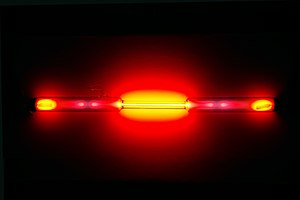Neon: Chemical element with symbol Ne and atomic number 10; rare gas
Neon is a chemical element on the periodic table.
It is part of the noble gas group and it has an atomic number of 10. It is an odorless and tasteless gas. Neon does not react with other elements, so it is found by itself. There is not much neon in the air, and it is clear, so we do not see it.
It was previously thought that Neon could not bond with any other elements, creating compounds. However, there have been a few compounds that have been made with neon, such as NeAuF and NeBeS.
History
Two British scientists, Sir William Ramsay and Morris Travers, discovered neon, argon, krypton, and xenon. Together they discovered a brand new gas element in 1898. Four years before, Ramsay, a physical chemist, had found argon and was the first person to isolate helium in 1895. The scientists froze argon, using liquid air, and then evaporated this to collect the gas that is produced. Using a high voltage, they collected the first sample of the gas. To their surprise, the gas illuminated the glass tubes and glowed with bright crimson light.
Upon discovery, the two scientists decided to name the new gas Neon, after the Greek word Neos, meaning the new one. While Ramsay and Travers discovered neon gas, they didn’t invent neon lamps. It wasn’t until 1902 when French engineer and inventor Georges Claude showcased the first neon light.
Uses
Neon gas is used in gas discharge lamps. When electricity goes through the neon, it lights up red. Due to this quality, it is used in light up signs. Similar signs use other gases to make other colors, but they are also often called "neon signs". Neon is also a term referring to a type of color that is very bright, such as lime green.
 | ||||||||||||||||||||||||||
| Neon | ||||||||||||||||||||||||||
|---|---|---|---|---|---|---|---|---|---|---|---|---|---|---|---|---|---|---|---|---|---|---|---|---|---|---|
| Appearance | colorless gas exhibiting an orange-red glow when placed in an electric field | |||||||||||||||||||||||||
| Standard atomic weight Ar°(Ne) | ||||||||||||||||||||||||||
| 20.1797(6) | ||||||||||||||||||||||||||
| Neon in the periodic table | ||||||||||||||||||||||||||
| ||||||||||||||||||||||||||
| Group | group 18 (noble gases) | |||||||||||||||||||||||||
| Period | period 2 | |||||||||||||||||||||||||
| Block | p-block | |||||||||||||||||||||||||
| Electron configuration | [He] 2s2 2p6 | |||||||||||||||||||||||||
| Electrons per shell | 2, 8 | |||||||||||||||||||||||||
| Physical properties | ||||||||||||||||||||||||||
| Phase at STP | gas | |||||||||||||||||||||||||
| Melting point | 24.56 K (−248.59 °C, −415.46 °F) | |||||||||||||||||||||||||
| Boiling point | 27.104 K (−246.046 °C, −410.883 °F) | |||||||||||||||||||||||||
| Density (at STP) | 0.9002 g/L | |||||||||||||||||||||||||
| when liquid (at b.p.) | 1.207 g/cm3 | |||||||||||||||||||||||||
| Triple point | 24.556 K, 43.37 kPa | |||||||||||||||||||||||||
| Critical point | 44.4918 K, 2.7686 MPa | |||||||||||||||||||||||||
| Heat of fusion | 0.335 kJ/mol | |||||||||||||||||||||||||
| Heat of vaporization | 1.71 kJ/mol | |||||||||||||||||||||||||
| Molar heat capacity | 20.79 J/(mol·K) | |||||||||||||||||||||||||
Vapor pressure
| ||||||||||||||||||||||||||
| Atomic properties | ||||||||||||||||||||||||||
| Oxidation states | 0 | |||||||||||||||||||||||||
| Ionization energies |
| |||||||||||||||||||||||||
| Covalent radius | 58 pm | |||||||||||||||||||||||||
| Van der Waals radius | 154 pm | |||||||||||||||||||||||||
 | ||||||||||||||||||||||||||
| Other properties | ||||||||||||||||||||||||||
| Natural occurrence | primordial | |||||||||||||||||||||||||
| Crystal structure | face-centered cubic (fcc) | |||||||||||||||||||||||||
| Speed of sound | 435 m/s (gas, at 0 °C) | |||||||||||||||||||||||||
| Thermal conductivity | 49.1×10−3 W/(m⋅K) | |||||||||||||||||||||||||
| Magnetic ordering | diamagnetic | |||||||||||||||||||||||||
| Molar magnetic susceptibility | −6.74·10−6 cm3/mol (298 K) | |||||||||||||||||||||||||
| Bulk modulus | 654 GPa | |||||||||||||||||||||||||
| CAS Number | 7440-01-9 | |||||||||||||||||||||||||
| History | ||||||||||||||||||||||||||
| Prediction | William Ramsay (1897) | |||||||||||||||||||||||||
| Discovery and first isolation | William Ramsay & Morris Travers (1898) | |||||||||||||||||||||||||
| Isotopes of neon | ||||||||||||||||||||||||||
| ||||||||||||||||||||||||||

Related pages
References
This article uses material from the Wikipedia Simple English article Neon, which is released under the Creative Commons Attribution-ShareAlike 3.0 license ("CC BY-SA 3.0"); additional terms may apply (view authors). Content is available under CC BY-SA 4.0 unless otherwise noted. Images, videos and audio are available under their respective licenses.
®Wikipedia is a registered trademark of the Wiki Foundation, Inc. Wiki Simple English (DUHOCTRUNGQUOC.VN) is an independent company and has no affiliation with Wiki Foundation.


